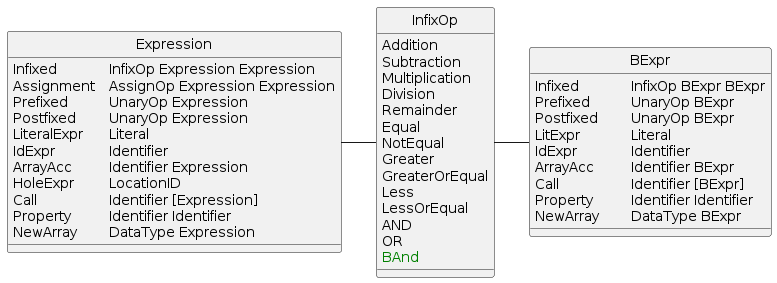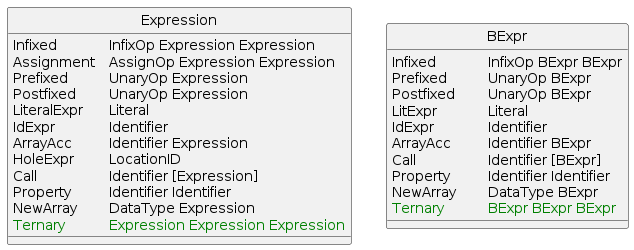-
Notifications
You must be signed in to change notification settings - Fork 0
Rules and Language Constructs
This page goes over design choices of various rules and language constructs.
This buggy rule asks for the following pattern to be encoded:
score = score - 3; ~> score =- 3;
count = count + 1; ~> count = count++;
score = score + 3; ~> score =+ 3;
count = count - 1; ~> count = count--;
As this pattern is simple, and more importantly is not restricted by the context, we can leverage a simple collection of rewrite rules for this. This rule is not restricted by the context because of a few reasons:
- It is a statement, not an expression.
- If this statement would be executed anywhere it would lead to unexpected results, because the left hand side is not semantically the same as the right.
These 4 rules contain the pattern:
x = x - a; ~> x =- a;
x = x + 1; ~> x = x++;
x = x + a; ~> x =+ a;
x = x - 1; ~> x = x--;
When refactoring a for loop that loops over an array into a foreach, it is easy to forget to update array accessors in the body of the loop. This is the behavior we try to capture:
for (int i = 0; i < values.length; i++) {
print (values[i]);
}Refactored into:
for (int i : values) {
print (values[i]);
}This is a harder pattern to construct a rule for, unless a lot of assumptions are taken. The easiest way to define a pattern for this is using a rewrite rule. This would contain the following pattern:
For(int x = 0; x < a.length; x++) body ~> ForEach(int x : a) body
This pattern assumes the following:
- The name of the index counter on the left is the same as the variable name on the right.
- As the datatype of
valuesis unknown during pattern matching we assume values is a list of integers. - We assume the body does not change at all, and thus array accessors are left in the body.
- This also assumes a loop that starts at 0 and loops towards the length
property of the list.
x <= a.length + 1would be semantically similar, but would not be recognized.
Some of these assumptions can be helped by simply defining more rules that match all the possible combinations. Being able to define a rule based on the input would make this easier, and view based rules give this possibility.
A view based rule would have to match for the following, based on the following structure:
For(init; cond; incr) body
- The statement is a
For. - The
initstarts at zero. - The
condloops until the length of a identifier. - The
incrincrements by one - The identifiers used for the index in 2, 3 and 4 are the same identifier.
After these matches the for can be rewritten to:
ForEach(int c : arr) body
Where c is the index identifier from 2, 3 or 4, and arr is the name
of the identifier for the array being looped over found in 2.
Now, the assumption of using the integer type can be helped as well: by
making the rule produce a [Statement] instead of Maybe Statement
multiple buggy steps can be encoded. The list should be a list of all
simple data types: integers, floating point numbers, characters,
strings. We cannot simply only produce the correct transformation, as
the type of arr is only known during runtime.
We want to implement support for the bitwise AND operator, as this operator was used multiple times in the experiment. For this, multiple stages of the tutor have to be modified. We start at the first step, being able to parse and evaluate the bitwise AND operator. For this the three stages in figure will have to be modified.
An modified vendored module is used to parse the code into an Java AST representing the Java code. This Java AST is very complex still, and needs to be converted into the Syntax AST used by the tutor. This is done in the parser. The Syntax AST is then used for rewrite rules. Although simpler than the Java AST, the Syntax AST still contains a lot of specifics unrelated to evaluating it, and thus is converted once again into a Base AST. This Base AST contains similar but a simplified structure of the Syntax AST. This Base AST is then fed to the evaluator, which evaluates and produces a result.
Because the bitwise operators are such a basic operators, it will need to be added to all three phases for it to work correctly. As it is an operator, it will need to be added to the following operator datatypes:
- Syntax AST:
InfixOp(Infixed Operator). - Base AST: reuses
InfixOpfrom the Syntax AST. - Evaluator:
Evaluation BExprusescalcto parseInfixOp.

After adding these definitions, the matching pipeline has to be updated as well. This pipeline is used for generating feedback. For this the converted Syntax AST needs to be able to be converted back into Java code. Figure shows the steps required. The Parser has already been updated in the previous paragraph, and the rules work on the same Syntax AST so do not need updating.
The pretty printer needs a suitable definition for the Pretty
typeclass on the InfixOp. This definition should give that
pretty after
parse is similar to the identity.
Similar to the bitwise operators, the ternary operator needs adding to
the same two pipelines. The ternary operator is an operator on its own,
and not part of a collection such as InfixOp, and therefore needs a
new constructor on multiple places. For the evaluation pipeline, these
are:
- Syntax AST:
Expressionneeds a newTernaryconstructor. - Base AST:
BExprneeds a newTernaryconstructor. - Evaluator:
Evaluation BExprneeds a new pattern match for theBExpr.Ternaryconstructor.
For converting the Syntax AST back to code, the pretty printer needs a
suitable definition for the Ternary constructor in the
Pretty Expression instance.
